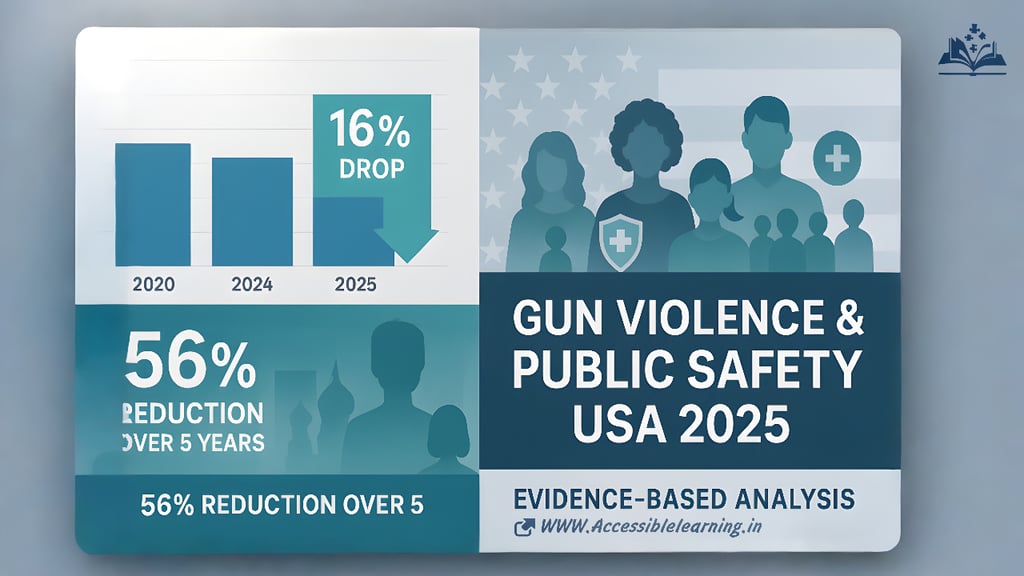
Gun Violence and Public Safety in the USA: A Comprehensive Analysis of Current Trends, Data, and Prevention Strategies
Comprehensive 2025 analysis of gun violence and public safety in the USA. Latest statistics, prevention strategies, and evidence-based solutions for safer communities.
USAPOLITICAL JOURNEYDARK SIDEAWARE/VIGILANTNEPOTISM/SOCIAL ISSUES
Keshav Jha \ Kim Shin
10/3/20256 min read


Understanding Gun Violence as a Public Health Crisis in America
Gun violence in the United States represents one of the most pressing public safety challenges of our time. In June 2024, the US Surgeon General issued an advisory declaring gun violence a public health crisis, marking a pivotal moment in how America approaches firearm-related deaths and injuries. This comprehensive analysis examines the latest data, trends, and evidence-based prevention strategies shaping public safety policy across the nation.
The scope of gun violence extends far beyond headline-grabbing mass shootings. It encompasses daily tragedies in communities nationwide, from domestic violence incidents to accidental shootings, creating ripple effects that impact families, neighborhoods, and entire regions. Understanding the full spectrum of firearm violence is essential for developing effective public safety responses and prevention strategies.
Current Gun Violence Statistics: What the Latest Data Reveals
2024-2025 Firearm Death Trends
Recent data shows encouraging signs of decline in gun violence rates. Firearm fatalities have fallen by 56% in the last five years. And from 2024 to 2025, gun deaths dropped 16%, indicating that prevention efforts may be yielding measurable results. However, the absolute numbers remain staggering.
In 2024, approximately 45,222 people in the U.S. lost their lives due to firearms, while in 2023, 46,728 people died by firearms in the United States—an average of one death every 11 minutes. These figures underscore the persistent nature of the gun violence epidemic, even as rates show improvement.
Breaking Down Gun Deaths by Category
The composition of gun deaths reveals critical insights for targeted prevention efforts. In 2023, 58% of all gun-related deaths in the U.S. were suicides (27,300), while 38% were murders (17,927). This distribution highlights that gun suicide prevention must be a central component of any comprehensive public safety strategy.
27,300 people died by firearm suicide, 17,927 died by firearm homicide, 463 died by unintentional gun injury, and an estimated 604 were fatally shot by law enforcement in 2023. These categories demonstrate that effective gun violence prevention requires multifaceted approaches addressing mental health, criminal justice reform, accident prevention, and police accountability.
Demographics Most Affected by Gun Violence
Gun violence disproportionately impacts specific demographic groups, creating urgent equity concerns. Firearm homicide rates are highest among: Teens and young adults ages 15-34, Black or African American persons, American Indian or Alaska Native persons, and Hispanic or Latino persons.
The racial disparity in gun violence victimization is particularly stark. 36 percent of the victims in 2024 were Black males between the ages of 15 and 34, a group that accounts for only 4 percent of the population. This disparity reflects broader systemic issues, including historical disinvestment in communities, economic inequality, and limited access to violence prevention resources.
Geographic Patterns and State-by-State Variations
Gun violence rates vary significantly across states, reflecting different policy environments, urban-rural dynamics, and socioeconomic conditions. States with stronger gun safety laws consistently demonstrate lower rates of firearm deaths, while those with weaker regulations experience higher rates of gun violence.
Regional differences also reflect varying approaches to public safety, with some areas emphasizing enforcement-focused strategies while others prioritize community-based violence intervention programs. Understanding these geographic patterns helps inform targeted resource allocation and policy development.
The Economic Impact of Gun Violence on Public Safety
The financial burden of gun violence extends far beyond immediate medical costs. Healthcare systems bear substantial expenses treating gunshot victims, while communities face long-term economic consequences from violence-related trauma, reduced property values, and business disruption.
Law enforcement agencies allocate significant resources to gun violence investigations, prevention programs, and emergency response. Courts and correctional systems process thousands of gun-related cases annually, creating additional costs for taxpayers. The total economic impact of gun violence, including lost productivity and quality of life measures, reaches hundreds of billions of dollars annually.

Evidence-Based Gun Violence Prevention Strategies
Community Violence Intervention Programs
Community violence intervention programs have emerged as one of the most promising approaches to reducing gun violence. In 2024, GIFFORDS tracked over 90 CVI-related bills in 25 states and Washington, DC, demonstrating growing recognition of these programs' effectiveness.
These initiatives work by identifying individuals at highest risk of gun violence involvement and connecting them with intensive services, mentorship, and alternative pathways. Successful programs combine street outreach, conflict mediation, and wraparound services to address root causes of violence.
Policy Interventions and Legislative Approaches
In states where elected officials have taken action to pass gun laws, fewer people die by gun violence, providing clear evidence that policy interventions can save lives. Effective gun safety policies include universal background check requirements, extreme risk protection orders, secure storage mandates, and permit-to-purchase systems.
The implementation of these policies varies significantly across jurisdictions, with some states adopting comprehensive approaches while others maintain minimal regulations. Research consistently demonstrates that states with stronger gun laws experience lower rates of firearm deaths across all categories.
Public Health Approaches to Gun Violence Prevention
Public health is the science of reducing and preventing injury, disease, and death and promoting the health and well-being of communities. Applying public health principles to gun violence involves treating it as a preventable epidemic requiring systematic intervention.
This approach emphasizes surveillance and data collection, risk factor identification, intervention development and testing, and widespread implementation of proven strategies. Public health frameworks also prioritize addressing social determinants of violence, including poverty, inequality, and trauma exposure.
The Role of Mental Health in Gun Violence and Suicide Prevention
Given that suicide represents the majority of gun deaths, mental health support and crisis intervention services play crucial roles in reducing gun violence. Effective suicide prevention strategies include means restriction, crisis counseling, and improved access to mental health treatment.
Healthcare providers increasingly recognize the importance of discussing firearm access with patients experiencing mental health crises. Safe storage counseling and temporary removal programs can provide critical breathing space during acute risk periods, preventing impulsive self-harm.
Technology and Innovation in Gun Violence Prevention
Emerging technologies offer new possibilities for enhancing public safety while respecting individual rights. Gunshot detection systems help law enforcement respond more quickly to incidents, potentially saving lives through faster medical intervention.
Smart gun technology, improved ballistics analysis, and predictive policing algorithms represent additional technological approaches to reducing gun violence. However, the implementation of these technologies must be carefully balanced with privacy considerations and community trust.


School Safety and Protecting Children from Gun Violence
School shootings, while statistically rare, create profound trauma and drive public demand for enhanced safety measures. Effective school safety approaches combine physical security improvements, threat assessment programs, and social-emotional learning initiatives.
Research indicates that comprehensive approaches addressing the underlying factors that contribute to school violence are more effective than single-solution strategies. This includes improving school climate, identifying and supporting struggling students, and ensuring appropriate intervention when warning signs emerge.
Community Resilience and Healing from Gun Violence Trauma
Communities affected by gun violence require comprehensive support systems to heal and build resilience. Trauma-informed care, victim services, and community healing initiatives help address the lasting impacts of firearm violence.
Survivor support programs, memorial services, and community organizing efforts provide pathways for channeling grief into positive action. Building community capacity to prevent future violence while supporting those already affected requires sustained investment and commitment.
Federal, State, and Local Coordination in Public Safety
Effective gun violence prevention requires coordination across all levels of government. On January 10, 2025, the Department of Justice released model legislation for states to consider as they evaluate how to address the growing threat posed by machine gun conversion devices, demonstrating ongoing federal efforts to support state and local prevention initiatives.
Successful coordination involves sharing data, resources, and best practices while respecting jurisdictional boundaries and community preferences. Multi-jurisdictional task forces, information-sharing systems, and joint funding initiatives help maximize the impact of prevention efforts.
Future Directions and Emerging Trends
The gun violence prevention field continues evolving as new research emerges and communities develop innovative approaches. Promising trends include increased focus on root cause interventions, expanded use of violence interruption models, and greater integration of public health approaches.
Technology integration, improved data collection systems, and enhanced evaluation methodologies will likely shape future prevention efforts. Community-driven solutions and grassroots organizing continue to play essential roles in driving policy change and program implementation.
Gun violence and public safety in America require sustained, evidence-based responses that address root causes while implementing proven interventions. The recent decline in gun deaths demonstrates that progress is possible, but continued effort is essential to build on these gains.
Effective prevention combines policy reform, community investment, mental health support, and technological innovation. Success requires collaboration across sectors, including government agencies, healthcare systems, educational institutions, and community organizations.
The path forward demands both urgency and patience, recognizing that sustainable change takes time while acknowledging that every day of delay costs lives. By maintaining focus on evidence-based approaches, supporting affected communities, and fostering meaningful dialogue, America can build safer communities for all residents.
The challenge of gun violence and public safety ultimately reflects broader questions about the kind of society we want to create. Through comprehensive action grounded in compassion, evidence, and shared commitment to human dignity, communities across America can work toward a future where all people can live free from the fear and trauma of gun violence.
Subscribe to our newsletter
All © Copyright reserved by Accessible-Learning
| Terms & Conditions
Knowledge is power. Learn with Us. 📚


